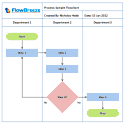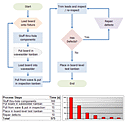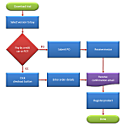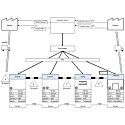Note: We Have Moved from Blogging to Writing Technical Articles
Instead of blogging, we have switched to writing technical articles on topics related to our products.
Click here to see our full article listing.
Flywheel Marketing for Software Companies
I JUST watched Rob Walling's talk from MicroConf 2012. Most of the talks were interesting, but the one by Rob was my personal favorite. It's a great talk, and I highly recommend watching it. One of the things that Rob touched upon was "Flywheel Marketing". Like its namesake, the concept is that you put the effort in up front, and like a flywheel, it keeps on going from its own momentum.
I've never had great success running AdWords campaigns. The Cost-Per-Click (CPC) is just too high for terms related to business diagramming. And, like many other articles have touched on, the CPC can be frustratingly high even for phrases that have no competition (a la CDC, perhaps CPC stands for Center for Profit Control). And lets face it, a flowchart add-in for Excel isn't the kind of software that TechCrunch is going to cover, or people will buzz about on social media sites. So for FlowBreeze, that leaves article writing as a straightforward marketing channel.
What I Do and Don't Mean by "Article"
When I refer to article writing, I mean producing quality content that helps people who are looking for information. I do not mean something from a cheap outsourcing site. What may surprise some people, though, is that I do not mean blogging.
Blogging is ephemeral. To give an example, a number of years ago, Joel on Software referenced an en brosse haircut. Having no idea what that was, I Googled it. The number one result was Joel's own blog post. Out of curiosity, I searched for it again a day later. It had dropped a few spots. A week later, it was still on the first page, but near the bottom. Checking again now, I can't find Joel's post in the top 100 for en brosse. Blog posts drop off your front page and and drift deeper into your site's hierarchy. Unless your blog has a lot of traction and a post gets a lot of links, blog posts don't seem to have the staying power of other written material. Plus, blogging always struck me as requiring too much effort to develop a repeat audience for garnering links. That's fine if that's your goal, but you have to be honest with yourself.
Getting Discouraged, Then Inspired

How to Flowchart in Word: 0 to 11k / month
OK, so I've talked about article writing, but how much have I actually done myself? Sadly, not as much as I should. I also hadn't been paying too much attention to the analytics for my existing article pages.
After watching Rob's video, I did a review of all my written content. I noticed that I netted a nice amount of sales from visitors who had landed on an article I was not expecting conversions from. The unique pageviews chart for the article is above. As you can see, it's a long term game, and if you're not targeting a link giving audience, you need to have patience. In fact, you need more patience than I had had.
This website benefited early on from a handful of articles I wrote when the site first launched. In the last part of 2011, I started writing again to spur more traffic and sales. Looking at the numbers for the first six months after publishing the fall 2011 block of articles, it just didn't look like the magic was going to happen again. The total traffic for all the BreezeTree article pages was going down! I became discouraged and decided to put my efforts elsewhere.
So a year later, when I decided to really delve into my analytics data, I discovered what the problem was. It's too easy to think that your website exists in a vacuum. The traffic for the fall 2011 articles had risen steadily over the course of the year, while the traffic for some of the older articles had fallen off. Some off the content had gotten stale, but the bigger issue was that there was more high quality content to compete with in my niche. It turns out that flywheel is not a perfect metaphor - there is maintenance.
(BTW, getting aggregate data in Google Analytics is simple, and getting detailed data on a single page isn't too bad. But when you want detailed, non-aggregate data on a large number of pages, it's an absolute pain in the ass.)
Motivated by the numbers and inspired by Rob Walling's video, I decided to step it up and work on some more articles.
A Few Simple Rules
As the amount of content on this blog attests to, I am not an prolific writer. So before writing the next block of articles, I decided to set out some ground rules:
- Stick to "How To" and "What is ...?" topics - reference pieces that hold up for a length of time.
- Write on topics related to my product.
- Write a mix of pieces with high traffic / broad appeal and lower traffic / niche appeal.
- Allot a block of time everyday for a week to write articles. Repeat when the muse strikes.
Odds are you are not going to find 100 things to write about related to your product, so it's important to stress quality over quantity. After exhausting the easy ideas, I circled the periphery, via brainstorming or by using Google's latent semantic indexing search to find related terms (search key phrases with a ~ in front of keywords). I came up with a grand total of (drum roll) 18 article ideas. Coming up with good ideas for articles is hard. Writing them is harder. I allotted 2-3 hours / day for one week and managed to write only 7 in that span.
The last bullet point above may be contrary to other advice that you read about writing frequently. I could have set a goal like that, but I know myself well enough to set the bar pretty low.
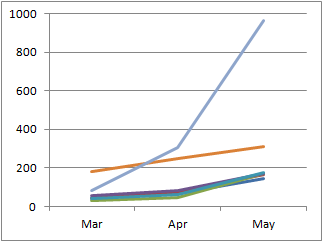
7 Articles - 3 Months of Visitor Data
3 Months Later
As you can see from the chart on the right, most of the articles have slowly been gaining traction, and one has shot up above the others. Success, right? Well, not immediately. To date, the articles have lead to no traceable sales conversions (according to Google Analytics page value metric, which has its limitations).
Again, this post is about Flywheel Marketing. The goal of writing articles is to put in a nominal amount of effort that has long term payoff. Three months is an reasonable checkpoint, but I may not know if the time spent writing will pay off for another year. Direct sales conversions are the optimal payoff, but they aren't the only goal. Another goal is to establish your site as an authoritative reference for a given genre.
I imagine someone with a high traffic site might think the graph to the right is abysmal. But when I spent only two hours writing an article about an obscure topic like Nassi-Shneiderman Diagrams, and it is trending towards an additional 2000 visitors / year to my site, it's a nice motivation towards more article writing.
One More Thing to Consider
If you use Google AdWords or other advertising channels, you can opt to show your ads on content networks. When you build up a body of article pages, you are creating a mini content network of your own. It's a great testing ground for your ad content. I put inline product banners in all the BreezeTree articles and A/B test headlines, content, styles, and buttons. The product banners account for a decent number of FlowBreeze downloads every month - enough that, just thinking about how much it would cost to get the same results through advertising, makes me want to hide my wallet.
Update
I stumbled across semrush.com, which provides traffic and advertising estimation data for websites. Like most of these tools, I'm sure their traffic estimations are a bit off, but they do provide one interesting metric: SE traffic price. It's the estimated amount that you would need to pay each month to get the same number of visitors through ads that you do through organic traffic. For breezetree.com, the estimate is $21,764 / month. Of course, you would need to multiply that by the percentage of article readers who click through to your product page, but it's still a pretty convincing reason to develop content for your site.
